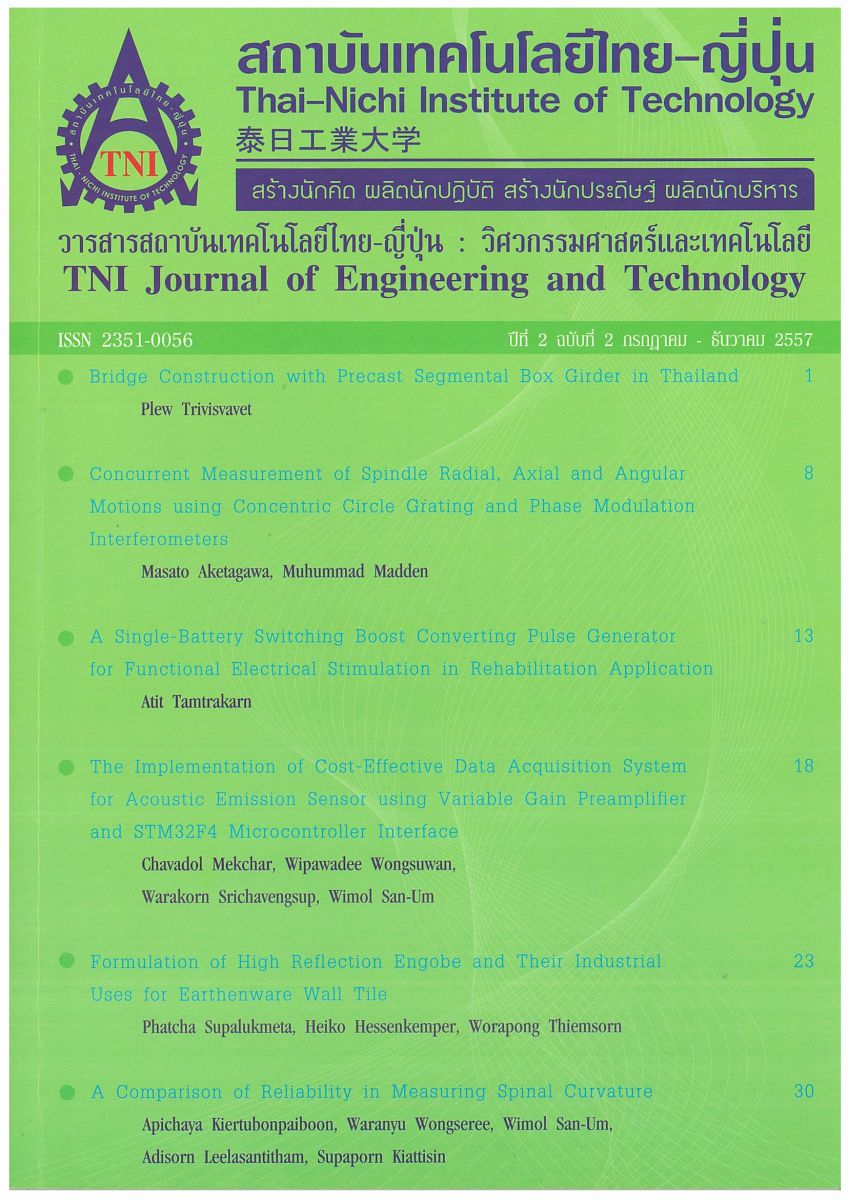A Single-Battery Switching Boost Converting Pulse Generator for Functional Electrical Stimulation in Rehabilitation Application
Main Article Content
บทคัดย่อ
This paper presents an application of using a switching boost converter in combination with two timer ICs for electrical stimulation in rehabilitation. The first timer IC generates a square wave pulse for the switching boost converter, while the second timer IC generates a clocking window for supplying the electrical stimulating signal to the patient in order to evoke a functional movement of the impair muscle of the patient through the specific set of nerves. The circuit implementation in this work can eliminate using of transformers. Thus, the circuit consumes smaller area than the conventional transformer approach and it does not require complicated design methodology. The simulation results show that the output waveform has frequency around 30Hz with pulse width around 220s and pulse voltage more than 10V which can be used as Functional Electrical Stimulation (FES) device. The circuit can be operated with only a single 3V-battery which is applicable for portable device.
Article Details
นโยบายการรับบทความ
กองบรรณาธิการวารสารสถาบันเทคโนโลยีไทย-ญี่ปุ่น มีความยินดีรับบทความจากอาจารย์ประจำ และผู้ทรงคุณวุฒิในสาขาวิศวกรรมศาสตร์และเทคโนโลยี ที่เขียนเป็นภาษาไทยหรือภาษาอังกฤษ ซึ่งผลงานวิชาการที่ส่งมาขอตีพิมพ์ต้องไม่เคยเผยแพร่ในสิ่งพิมพ์อื่นใดมาก่อน และต้องไม่อยู่ในระหว่างการพิจารณาของวารสารอื่นที่นำส่ง ดังนั้นผู้สนใจที่จะร่วมเผยแพร่ผลงานและความรู้ที่ศึกษามาสามารถนำส่งบทความได้ที่กองบรรณาธิการเพื่อเสนอต่อคณะกรรมการกลั่นกรองบทความพิจารณาจัดพิมพ์ในวารสารต่อไป ทั้งนี้บทความที่สามารถเผยแพร่ได้ประกอบด้วยบทความวิจัย ผู้สนใจสามารถศึกษาและจัดเตรียมบทความจากคำแนะนำสำหรับผู้เขียนบทความ
การละเมิดลิขสิทธิ์ถือเป็นความรับผิดชอบของผู้ส่งบทความโดยตรง บทความที่ได้รับการตีพิมพ์ต้องผ่านการพิจารณากลั่นกรองคุณภาพจากผู้ทรงคุณวุฒิและได้รับความเห็นชอบจากกองบรรณาธิการ
ข้อความที่ปรากฏภายในบทความของแต่ละบทความที่ตีพิมพ์ในวารสารวิชาการเล่มนี้ เป็น ความคิดเห็นส่วนตัวของผู้เขียนแต่ละท่าน ไม่เกี่ยวข้องกับสถาบันเทคโนโลยีไทย-ญี่ปุ่น และคณาจารย์ท่านอื่น ๆ ในสถาบัน แต่อย่างใด ความรับผิดชอบด้านเนื้อหาและการตรวจร่างบทความแต่ละบทความเป็นของผู้เขียนแต่ละท่าน หากมีความผิดพลาดใด ๆ ผู้เขียนแต่ละท่านจะต้องรับผิดชอบบทความของตนเองแต่ผู้เดียว
กองบรรณาธิการขอสงวนสิทธิ์มิให้นำเนื้อหา ทัศนะ หรือข้อคิดเห็นใด ๆ ของบทความในวารสารสถาบันเทคโนโลยีไทย-ญี่ปุ่น ไปเผยแพร่ก่อนได้รับอนุญาตจากผู้นิพนธ์ อย่างเป็นลายลักษณ์อักษร ผลงานที่ได้รับการตีพิมพ์ถือเป็นลิขสิทธิ์ของวารสารสถาบันเทคโนโลยีไทย-ญี่ปุ่น
ผู้ประสงค์จะส่งบทความเพื่อตีพิมพ์ในวารสารวิชาการ สถาบันเทคโนโลยีไทย-ญี่ปุ่น สามารถส่ง Online ที่ https://www.tci-thaijo.org/index.php/TNIJournal/ โปรดสมัครสมาชิก (Register) โดยกรอกรายละเอียดให้ครบถ้วนหากต้องการสอบถามข้อมูลเพิ่มเติมที่
- กองบรรณาธิการ วารสารสถาบันเทคโนโลยีไทย-ญี่ปุ่น
- ฝ่ายวิจัยและนวัตกรรม สถาบันเทคโนโลยีไทย-ญี่ปุ่น
เลขที่ 1771/1 สถาบันเทคโนโลยีไทย-ญี่ปุ่น ซอยพัฒนาการ 37-39 ถนนพัฒนาการ แขวงสวนหลวง เขตสวนหลวง กรุงเทพมหานคร 10250 ติดต่อกับคุณพิมพ์รต พิพัฒนกุล (02) 763-2752 , คุณจุฑามาศ ประสพสันติ์ (02) 763-2600 Ext. 2402 Fax. (02) 763-2754 หรือ E-mail: JEDT@tni.ac.th
เอกสารอ้างอิง
S. Simcox, G. Davis, A. Barriskill, J. Middleton, I. Bruinsma, M.Duncan, and R. Smith, “A portable, 8-channel transcutaneous stimulator for paraplegic muscle training and mobility-A technical note,” Journal of Rehabilitation Research and Development, vol. 41 Number 1, pp. 41–52, Jan. 2004.
C. A. Phillips, “Functional Electrical Stimulation and Lower Extremity Bracing for Ambulation Exercise of the Spinal Cord Injured Individual: A Medically Prescribed System,” Physical Therapy, Volume 69, No.10, pp.56-63, October 1989.
J. Cover, “Weapon for immobilization and capture,” U.S. Patent 3803463 A, April 9, 1974.
“TS3V555 data sheet,” ST Microelectronics, Geneva, Switzerland.
“Application Report: AN-1994 Modelling and Design of Current Mode Control Boost Converters,” Texas Instruments, United State of America, April 2013.


